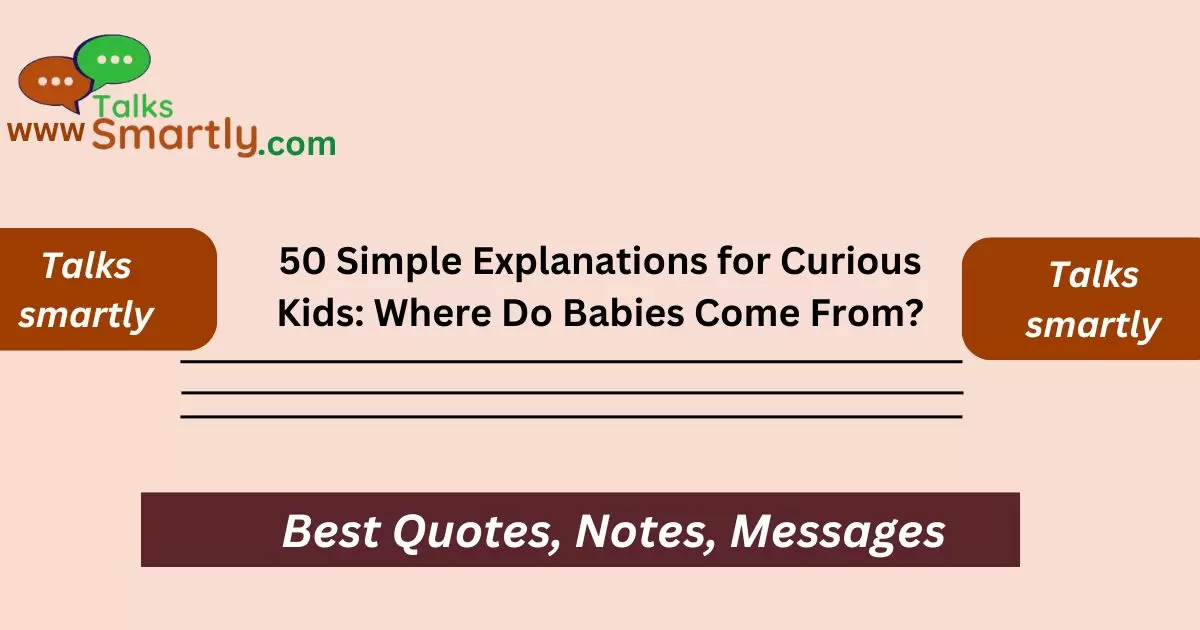Introduction
50 simple explanations for answering kids’ questions about where babies come from. This guide offers easy-to-understand answers for curious young minds.
Kids are naturally curious, especially about where babies come from. They ask questions that are often difficult to answer. This article will help you provide simple and clear explanations. We aim to make these conversations easier and more understandable. By using straightforward language, you can address their curiosity effectively.
Explore the article to find easy explanations that will help you answer those tough questions. Each explanation is designed to be child-friendly and straightforward. You can use these explanations to help satisfy their curiosity in an age-appropriate way. Click through and discover how to make these conversations simpler.
This article, “50 Simple Explanations for Curious Kids: Where Do Babies Come From?” provides practical and clear answers to common questions. Each explanation is crafted to be easy to understand and suitable for young children. With these explanations, you’ll be better prepared to handle their questions with confidence and clarity.
Simple Biological Explanations
- Mommies have eggs inside them and daddies have sperm. When a sperm meets an egg, they join together to create a baby in the mommy’s belly.
Explanation: Use clear names for body parts and focus on the basic biological process. Avoid euphemisms and emphasize that creating a baby is a special process for adults. - A baby starts to grow inside a special area in the mommy’s belly called the uterus. The baby grows from a tiny cell into a full baby.
Explanation: Highlight the role of the uterus in baby development and use straightforward language to describe growth. - When a sperm from the daddy meets an egg from the mommy, it starts the process of making a baby. The baby grows in the mommy’s tummy for about nine months.
Explanation: Emphasize the time it takes for a baby to develop and keep the description simple and factual. - Inside the mommy’s body, there is a safe place called the uterus where the baby grows. The sperm and egg come together in this safe place to make a baby.
Explanation: Focus on the protective environment of the uterus and use proper names for body parts. - A tiny part of the daddy called sperm joins with a tiny part of the mommy called an egg. This new tiny life starts growing in the mommy’s uterus.
Explanation: Use clear terminology for the sperm and egg and explain the growth process in a straightforward manner.
Metaphors and Analogies
- Imagine the sperm as a tiny helper and the egg as a tiny home. When the helper arrives at the home, they work together to build a baby.
Explanation: Use simple metaphors to make the concept more relatable while ensuring the biological process is clear. - Think of the baby as a seed that needs a special garden to grow. The mommy’s tummy is like a garden where the seed grows into a baby over time.
Explanation: Use gardening metaphors to explain growth, keeping the process understandable without being overly complicated.
Books and Videos
- Books like “The Berenstain Bears’ New Baby” or videos from trusted educational sources can show how babies grow and are born. They explain it in a way that’s easy for kids to understand.
Explanation: Recommend resources that present the information in a child-friendly format and reinforce proper understanding.
Real-Life Examples
- When a family decides to have a baby, they might visit a doctor to learn more about how babies are made and how they grow. The doctor helps them understand the process.
Explanation: Relate the concept to real-life situations, such as doctor visits, to make the process more tangible for children.
The Playground Question
“While playing at the park, my 6-year-old daughter suddenly asked, ‘How do babies get into their mommy’s tummy?’ I paused and replied, ‘When a mommy and daddy decide to have a baby, a tiny part from each of them join together in the mommy’s tummy. That’s how a baby starts to grow.’ She seemed satisfied and continued playing, but I know we’ll have more conversations like this in the future.” – Lisa, mom of 2
The Bedtime Chat
“During bedtime, my 5-year-old son asked, ‘Where do babies come from, Mom?’ I gently explained, ‘Babies grow in a special place inside mommy called the uterus. When mommy and daddy decide to have a baby, a tiny part from each joins together in the uterus to start making the baby.’ He looked thoughtful and said, ‘Oh, I see!’ We wrapped up the conversation with a bedtime story.” – John, dad of 1
The Grocery Store Inquiry
“While shopping for groceries, my 4-year-old son spotted a pregnant woman and asked, ‘Mom, why is that lady’s tummy so big?’ I replied, ‘She’s growing a baby inside her tummy. When a mommy and daddy want a baby, the baby starts growing there.’ He seemed fascinated and said, ‘Cool!’ It was a simple explanation, but it seemed to answer his curiosity for now.” – Rachel, mom of 3
The School Pickup
“On the way home from preschool, my 5-year-old daughter asked, ‘How did the baby get in your belly?’ I took a deep breath and said, ‘A tiny part from mommy and daddy come together inside mommy’s tummy and that’s how a baby starts growing.’ She nodded and said, ‘That’s neat!’ I was glad to provide an answer she could understand.” – Mike, dad of 2
The Family Dinner
“During dinner, my 6-year-old asked, ‘Where do babies come from, Mom?’ I calmly explained, ‘A baby starts to grow in a special place inside mommy called the uterus. The baby starts from a tiny part that comes from both mommy and daddy.’ My child was curious but seemed to accept this simple explanation.” – Anne, mom of 2
The Park Playdate
“At a playdate, my 4-year-old friend asked, ‘How do babies get in the mommy’s belly?’ I explained, ‘When a mommy and daddy decide they want a baby, a tiny part from each of them join together inside the mommy’s belly, and that’s where the baby grows.’ The child looked satisfied and went back to playing.” – Sarah, mom of 1
The Doctor’s Visit
“While waiting for a checkup, my 3-year-old daughter saw a pregnant woman and asked, ‘How did the baby get in there?’ I said, ‘When a mommy and daddy want to have a baby, they put a tiny part inside the mommy’s tummy, and the baby starts to grow.’ My daughter seemed to understand and continued playing with her toys.” – Emily, mom of 2
The Beach Conversation
“While building sandcastles at the beach, my 5-year-old son asked, ‘Where do babies come from?’ I said, ‘A baby starts to grow inside a special place in mommy’s tummy when a tiny part from mommy and daddy come together.’ He thought about it and said, ‘Okay, I get it!’ It was a good moment to give a simple explanation.” – Tom, dad of 2
The Afternoon Nap

“During nap time, my 4-year-old daughter asked, ‘How do babies get into mommy’s tummy?’ I told her, ‘When mommy and daddy want to have a baby, they put a tiny part from each into mommy’s tummy, and that’s where the baby starts to grow.’ She nodded and said, ‘Got it!’ It was a straightforward answer that worked for her age.” – Jessica, mom of 2
The Bedtime Story
“While reading a bedtime story, my 5-year-old son asked, ‘Where do babies come from?’ I explained, ‘A baby starts to grow in a special place inside mommy called the uterus, from a tiny part of mommy and daddy.’ He seemed to understand and said, ‘Okay, that’s cool!’ It was a calm way to answer his question.” – David, dad of 1
Sincere Apology Messages to Reconnect with Your Best Friend
Example Conversations
- Child: “Where do babies come from?” Parent: “Babies start growing inside a special place in mommy’s body called the uterus. When a tiny part from mommy and daddy join together, they begin to grow into a baby.”
Explanation: Provide a sample dialogue to guide parents in answering questions clearly and accurately.
Child: Hey Mom, I’m curious, how do babies get made?
Mom: That’s a great question! When a mommy and daddy decide they want to have a baby, it starts with something special. The daddy’s sperm meets the mommy’s egg. The sperm and egg come together in the mommy’s uterus, and then a baby begins to grow.
Child: How does the sperm get to the egg?
Mom: The daddy’s sperm travels through his penis and into the mommy’s vagina. From there, the sperm moves up into the mommy’s uterus where it meets the egg. Once they join, the baby starts to develop!
Child: That’s interesting! So, does it happen right away?
Mom: Not immediately. It takes some time for the sperm to find the egg and for the baby to grow. After that, the baby stays in the mommy’s belly for about nine months before being born.
Child: Thanks, Mom! That makes sense now.
Mom: You’re welcome! If you have more questions or want to know anything else, just ask. I’m always here to help!
Child: Dad, I heard some things about how babies are made, but I don’t really get it. Can you explain?
Dad: Sure thing! Basically, making a baby involves a sperm from a dad and an egg from a mom. The sperm fertilizes the egg, and then the fertilized egg attaches to the mom’s uterus where it starts to grow into a baby.
Child: Okay, so how does the sperm get to the egg?
Dad: The sperm is released during a special act between the parents and travels through the mom’s vagina to reach the egg in her uterus. It’s a bit like a race to find the egg!
Child: Oh, I see. And what happens after the egg is fertilized?
Dad: Once the egg is fertilized, it grows in the mom’s uterus. This process takes about nine months, and then the baby is born. It’s quite a journey!
Child: That’s pretty cool. Thanks for explaining!
Dad: No problem at all! It is amazing how life works. If you have any more questions, just let me know. I’m always happy to talk!
Child: Mom, can you explain how babies are created?
Mom: Of course! When a mommy and daddy decide they want to have a baby, it starts with their bodies coming together. The daddy’s sperm and the mommy’s egg join in the mommy’s uterus. This starts the process of making a baby.
Child: How does the sperm get inside the mommy?
Mom: The sperm travels from the daddy through his penis and into the mommy’s vagina. It then makes its way to the uterus where it meets the egg. Once they connect, the baby begins to form.
Child: And then how does the baby grow?
Mom: The baby grows in the mommy’s belly for about nine months. During this time, the baby develops until it’s ready to be born.
Child: Got it. Thanks for explaining that!
Mom: You’re welcome! Feel free to ask me anything else whenever you’re curious. I’m here for you!
Child: Dad, can you tell me how babies are made?
Dad: Sure! The process involves a sperm from a male and an egg from a female. When they join together inside the female’s uterus, a baby starts to develop.
Child: How does the sperm get to the egg?
Dad: The sperm travels through the female’s vagina to reach the uterus. Once it meets the egg, the baby starts to form and grow over the next nine months.
Child: That’s a lot more complex than I thought!
Dad: It can be, but it’s a natural part of life. If you have any more questions or need clarification, just let me know. I’m always here to help.
Child: Thanks, Dad. I’ll definitely ask if I think of anything else.
Dad: Anytime! Happy to help you out. See you later!
Tips for Having “The Talk”
- Use correct terminology: It’s important to use the proper names for body parts (penis, vagina, uterus) to avoid confusion and build a foundation of trust.
- Keep it simple: Use age-appropriate language and explanations. Avoid overloading children with too much detail.
- Be honest but reassuring: Provide truthful information while ensuring the child feels safe and comfortable.

- Encourage questions: Allow the child to ask follow-up questions and answer them as clearly as possible.
- Revisit the topic: Keep the conversation open and revisit the topic as the child grows and their understanding evolves.
Conclusion
In conclusion, explaining where babies come from to curious kids can be both a simple and informative process. By providing age-appropriate and clear answers, you can address their questions in an honest yet gentle manner.
It’s essential to use simple language and avoid overwhelming details, ensuring that the explanation is suitable for their understanding.
By fostering an open and supportive environment, you help nurture their curiosity and learning, setting the foundation for healthy and positive attitudes towards such topics in the future.












